How can producers help piglets resist stressors at weaning, increase performance & reduce the need for antimicrobials? Through an optimal nutritional strategy.
February 10, 2022
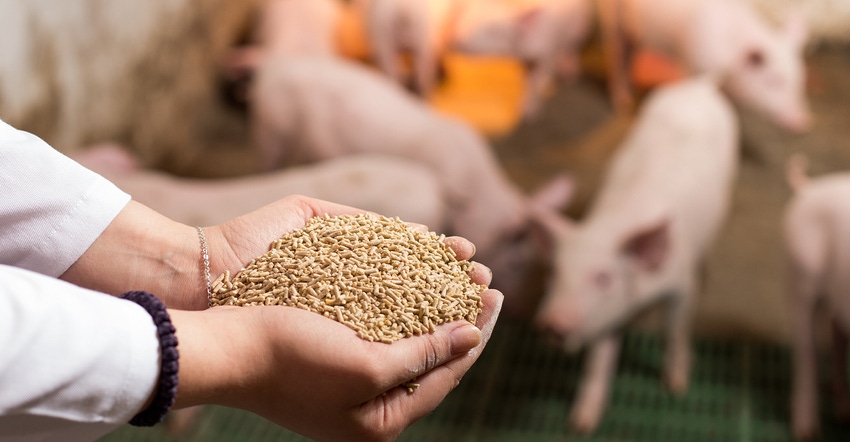
Sponsored Content
By : Fellipe Freitas Barbosa, Team Lead Global Technical Management Swine, EW Nutrition
A variety of stressors simultaneously occur at weaning, making this probably the most challenging period in pig production. During weaning, we commonly see altered gut development and gut microbiome, which increases piglets' vulnerability to diseases. The most classic clinical symptom resulting from these stressors is the occurrence of post-weaning diarrhea. It is a sign that something went wrong, and piglet development and overall performance may be compromised (Guevarra et al. 2019).
Besides weaning, an unavoidable practice in pig production, the swine industry has been facing other changes. Among them, the increased pressure to reduce the use of antimicrobials stands out. Antimicrobials are often associated with improved piglet performance and health. Their usage has been reduced worldwide, however, due to the threat of antimicrobial resistance that affects not just animal health but also human health (Cardinal et al., 2019).
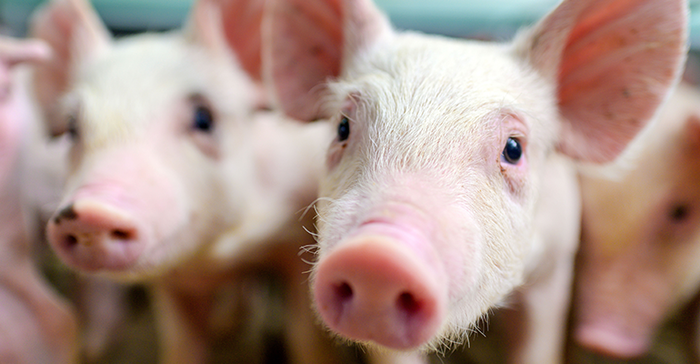
Reduce antimicrobials and post-weaning diarrhea: can piglet nutrition achieve both?
With these drastic changes for the piglets and the global swine industry, producers must find solutions to keep their farms profitable — especially from a nutritional perspective. Our last article presented two feed additives that can be part of an antibiotic-free concept for post-weaning piglets. This article will highlight a few essential nutritional strategies that swine producers and nutritionists must consider when formulating post-weaning feed without or with reduced amounts of antimicrobials.
What makes weaning so stressful for piglets?
Producers, nutritionists, and veterinarians all agree that weaning is a tough time for piglets (Yu et al., 2019) and, therefore, a challenge to all those involved in the pig production chain. Although there is a global trend towards increasing weaning age, generally speaking, animals are still immature when going through the weaning process. They face several physiological, nutritional, and environmental changes (figure 1).
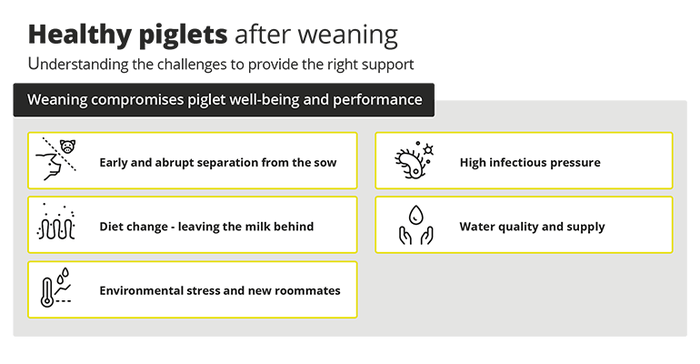
Most of these changes become "stressors" that trigger a cascade of reactions affecting the balance and morphology of the intestinal microbiome (figure 2). The outcome is a decrease in the piglets' well-being and, in most cases, performance. We need to clearly understand how these stressors affect pigs to develop effective strategies against post-weaning growth impairments, especially when no antimicrobials are allowed.
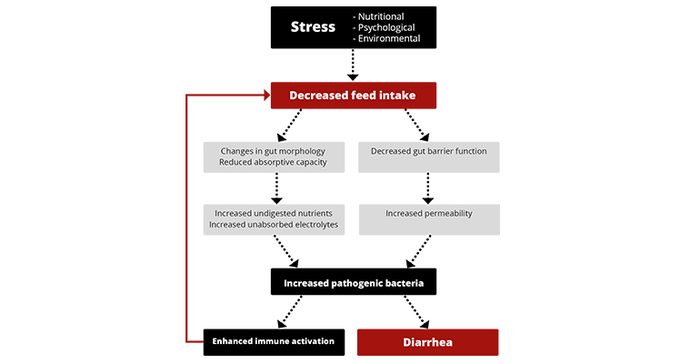
Weaning support starts before weaning
The use of creep feed has been evaluated and even criticized for many years. Some operations are still reluctant to use such a feed due to its high cost and amount of labor on the farm, with manually providing feed and cleaning feeding trays. In addition, some questions have been raised regarding the ideal composition of the creep feed – how much complexity should we add to this special diet?
Therefore, the benefits of creep feed are under re-evaluation, not only considering piglet physiology per se, but also feed characteristics and different feeding programs. Recent studies have questioned highly complex creep feed formulations. Creep feed is being called "transition feed" (Molist, 2021) – i.e., that meal which is complementary to sows’ milk and not a replicate of it, helping piglets during the period of changing its main source of nutrients. We must, therefore, look at it as a way of making piglets familiar with solid feed, as highlighted by Mike Tokach during the 2020 KSU Swine Day. Dr. Tokach also mentioned that the presence of feeders in the lactation pen could stimulate the exploratory behaviors of the piglets. Combined, these practices can lead to a higher feed intake and performance during the nursery phase.
Towards a pragmatic stance on creep feed
Heo et al. (2018) evaluated three different creep feed types: a highly digestible creep feed, weaning feed as creep feed, and sow feed as creep feed until weaning. Piglets receiving the highly digestible creep had higher feed intake during the second to the last week pre-weaning (14 to 21 days of age) and higher ADG during the last week pre-weaning (21 to 28 days of age). This resulted in a trend for higher weaning weight. However, these benefits did not persist after weaning when all piglets received the weaning feed.
Guevarra et al. (2019) also suggested that the abrupt transition in piglet nutrition to a more complex nutrient source can influence shifts in the gut microbiota, impacting the absorptive capacity of the small intestine. Yang et al. (2016) evaluated 40 piglets from eight litters during the first week after weaning. They found that the change in diet during weaning reduced the proliferation of intestinal epithelial cells. This indicates that this period affects cellular macromolecule organization and localization, in addition to energy and protein metabolism. These results suggest that "similarity" in feed pre- and post-weaning may contribute more to the continuity of nutrient intake post-weaning than a highly complex-nutrient dense creep feed.
Nutritional strategies without antibiotics: focus on pig physiology
As mentioned, it is crucial to avoid a drastic drop in feed/nutrient intake after weaning compared to pre-weaning levels. In a classic study, Pluske et al. (1996) showed the importance of high intake levels on villus weight (used as a reference for gut health, cf. graph 1). Although not desirable, the reduction should be considered "normal" behavior.
Imagine these recently weaned piglets, facing all these stressors, having to figure out within this new group of peers when it is time to eat, where to find food, why water and food now come from two distinct sources… Therefore, management, feeding, water quality, and other aspects play important roles in post-weaning feed intake (figure 3).
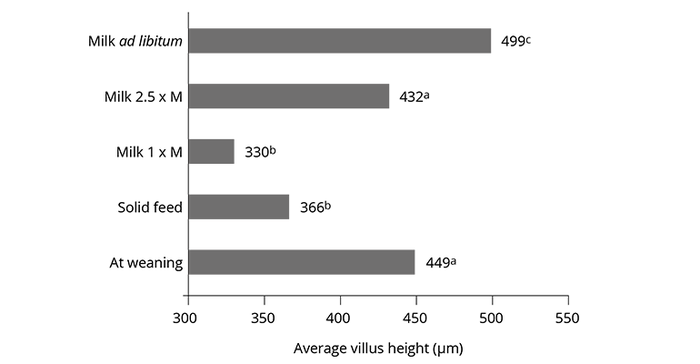
From a nutritional perspective, piglets at weaning experience a transition from milk (a high-fat, low-carbohydrate liquid) to a plant-based diet (a solid, low-fat, and high-carbohydrate diet) (Guevarra et al., 2019). Even when previously introduced to solid feed, it is still difficult for their enzymatic system to cope with grains and beans.
One of the consequences of the lower digestibility capacity is an increase of undigested nutrients. Harmful bacteria thrive and cause diarrhea, reducing even further an already compromised feed intake. This cycle must be broken with the support of formulations based on piglet physiology.
Post-weaning feed must support digestion and nutrient absorption, including the largest possible share possible of high-quality, digestible ingredients, with low anti-nutritional factors. High-performing feed also integrates functional amino acids, functional carbohydrates, and additives to support the intestinal mucosa and gut microbiome.
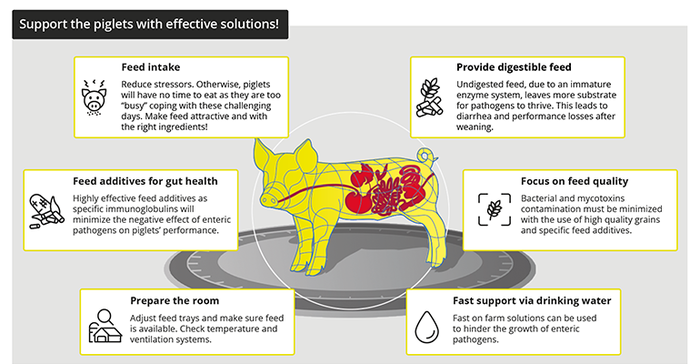
Crude protein – more of the same?
Levels of crude protein in piglet feed have been in the spotlight for quite some time. The topic can be very controversial where the exact percentage of crude protein in the final feed is concerned. Some nutritionists pragmatically recommend maximal levels of 20% in the weaner feed. Others go a bit lower, with some formulations reaching 17 to 18% total crude protein. Levels above 20% will incur high costs and may accentuate the growth of pathogenic bacteria due to a higher amount of undigested protein in the distal part of the small intestine (figure 4).
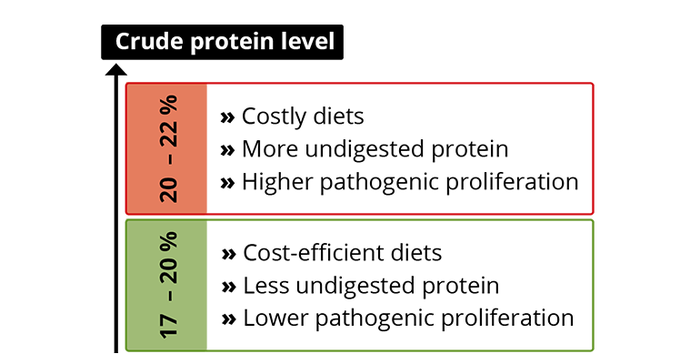
What is not open for discussion, however, is the quality of the protein used, in terms of:
digestibility,
the total amount of anti-nutritional factors, and
the correct supply of essential and non-essential amino acids (particularly lysine, methionine, threonine, tryptophane, isoleucine and valine).
The critical role of digestibility
High-digestibility ingredients for piglets need to deliver < 85% digestibility. In most cases, to reach high biological values (correlating to high digestibility), these ingredients typically undergo different processing steps, including heat, physical, and chemical treatments. Animal by-products (such as hydrolyzed mucosa, fish meal, spray-dried plasma) and processed vegetable sources (soy protein concentrate, extruded grains, potato protein) can be used in high amounts during this phase. They will notably reduce the total amount of undigested protein reaching the distal part of the intestine, with 2 main benefits:
Less substrate for pathogenic bacteria proliferation (and therefore lower incidence of diarrhea)
Lower nitrogen excretion to the environment
It is common knowledge that certain storage proteins from soybean meal (for instance, glycinin and B-conglycinin) can cause damage to piglets' intestinal morphology and trigger the activation of the immune system. However, it is normal practice to introduce this ingredient to piglets around weaning so that the animals can develop a certain level of tolerance to such compounds (Tokach et al., 2003). In Europe, where most diets are wheat-barley based, soybean meal is included in levels varying from 3 to 9% in the first 2 diets, with gradual increases during the nursery phase.
Amino acids and protein: manage the balance
When the supply and balance between essential and non-essential amino acids is concerned, reducing total crude protein brings indeed complexity to the formulations. The concept of ideal amino acid should be expanded, ideally, to all 9 essential amino acids (lysine, methionine, tryptophan, threonine, valine, isoleucine, leucine, histidine, and phenylalanine). In most cases, formulations go up to the 5th or 6th limiting amino acid. Lawor et al. (2020) suggest 2 practical approaches to avoid deficiencies when formulating low-protein piglet feed:
Maintain a maximum total lysine to crude protein ratio in the diet of 7.1 to 7.4%
Do not exceed the SID lysine to crude protein ratio of 6.4%
Some conditionally essential amino acids (e.g. arginine, proline, and glutamine) also play critical roles in diets with reduced crude protein levels. Glutamine is especially interesting. When supplemented in the feed, it can be used as a source of energy by the intestinal epithelium and, therefore, prevent atrophy and support nutrient absorption, resulting in better growth post-weaning (Hanczakowska and Niwińska, 2013; Watford et al., 2015)
The importance of the buffer capacity of the feed – supporting the enzymatic system
Given the move towards antibiotic reduction, this topic is more relevant than ever to nutritionists worldwide. The acid-binding capacity (also known as buffering capacity) of the feed directly affects the capacity of the stomach to digest protein. Hence, buffer capacity is of utmost importance in antimicrobial-free diets as it influences the growth of pathogenic bacteria (Lawlor et al., 2005).
In short, the acid-binding capacity is the resistance of an ingredient or complete feed to pH change. For piglet feed/feed ingredients, it is normally measured by the acid-binding capacity at pH4 (ABC-4). A higher ABC-4 equates to a higher buffering capacity. Feed with a high ABC-4 would require large amounts of gastric acid for the pH of the stomach to reach 4 and below. As the post-weaned piglet has limitations on producing and secreting acid, the stomach pH would stay high and, thus, less favorable for protein digestion.
The recommendation is to have a complete feed based on single ingredients with low ABC-4 values and to use additives that further reduce the ABC-4 value (such as organic acids). According to Molist (2020), post-weaning feed must have an ABC-4 that is lower than 250-300 meq/kg.
Talking about fiber
Dietary fibers are also known for regulating intestinal health in both humans and animals. Chen et al. (2020), for example, examined the effects of dietary soluble fibers (inulin) and insoluble fibers (lignocellulose) in weaned piglet diets for four weeks. Results showed that combining those fibers can positively influence nutrient digestibility, gut microbiota composition, intestinal barrier functions, and growth performance (table 1 ).
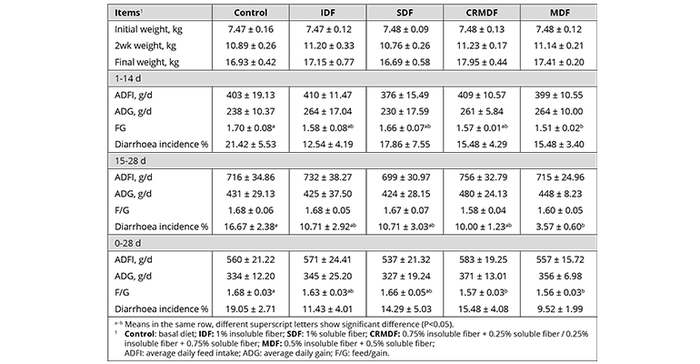
How to reduce antimicrobials? Understand the roles of piglet physiology and nutrition
Swine producers might think that "How can I reduce antimicrobial use on my farm?" and "How can I improve the performance of piglets at weaning?" are two separate questions. However, that is not always the case. Answers based on a deep understanding of physiology and nutrition dynamics help piglets overcome the challenges encountered during weaning – and, thus, lessen the need for antimicrobial interventions.
In this article, we have explored the basic principles that are the basis for ensuring the performance and health of the post-weaning piglet. Although we do not have a singular solution for eliminating antimicrobials on our pig farms, we can count on a group of robust and integrated nutritional strategies. By integrating factors ranging from management to feed additives, these solutions can improve piglet health and performance throughout their lives.
References are available on request.
About the Author(s)
You May Also Like



